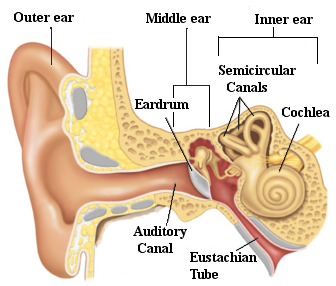The ear is the organ ofhearing. The outer ear protrudes away from the head and is shaped like a cup to direct sounds toward the tympanic membrane, which transmits vibrations to the inner ear through a series of small bones in the middle ear called themalleus,incusandstapes. The inner ear, or cochlea, is a spiral-shaped chamber covered internally by nerve fibres that react to the vibrations and transmit impulses to thebrainvia the auditory nerve. Thebraincombines the input of our two ears to determine the direction and distance of sounds.

The human ear can perceive frequencies from 16 cycles per second, which is a very deep bass, to 28,000 cycles per second, which is a very high pitch. Bats and dolphins can detect frequencies higher than 100,000 cycles per second. The human ear can detectpitchchanges as small as 3 hundredths of one percent of the original frequencyFrequency is the number of occurrences( repetition or oscill... More in some frequencyFrequency is the number of occurrences( repetition or oscill... More ranges. Some people have “perfect pitch”, which is the ability to map a tone precisely on the musical scale without reference to an external standard.
It is estimated that less than one in ten thousand people have perfect pitch, but speakers of tonal languages like Vietnamese and Mandarin show remarkably precise absolute pitch in readingA Reading on a measuring instrument or tool in physical scie... More out lists of words because pitch is an essential feature in conveying the meaning of words in tone languages. The Eguchi Method teaches perfect pitch to children starting before they are 4 years old. After age 7, the ability to recognise notes does not improve much.
Functions of the human ear
We can hear with the help of one of the highly sensitive organ of our body calledthe ear. Audible frequencies help the ear convert pressure variations in air into electrical signals that travel to our brains through auditory nerve.
The outer ear which we see is called pinna and collects sound from the surroundings. This collected sound passes through the auditory canal, at the end of which there is a thin membrane called ear drum or tympanic membrane. The sound travels through a series ofcompression and rarefactionsthrough the medium. When one such compressionCompression: The process or result of becoming smaller or pr... More of the medium reaches the eardrum the pressure on the outside of it increases and pushes the eardrum inward.
In the same way, the eardrum moves outward. When a rarefaction reaches its so the eardrum vibrates in this way. These vibrations are amplified a number of times by three bones named hammer, anvil and stirrup in the middle ear, which transmits the amplified pressure variations received from the sound wave to the inner ear. In the inner ear the pressure vibrations are turned into electrical signals by the cochlea. These electrical signals are transmitted to the brain through auditory nerve and the brain interprets the electrical signal to sound again.


